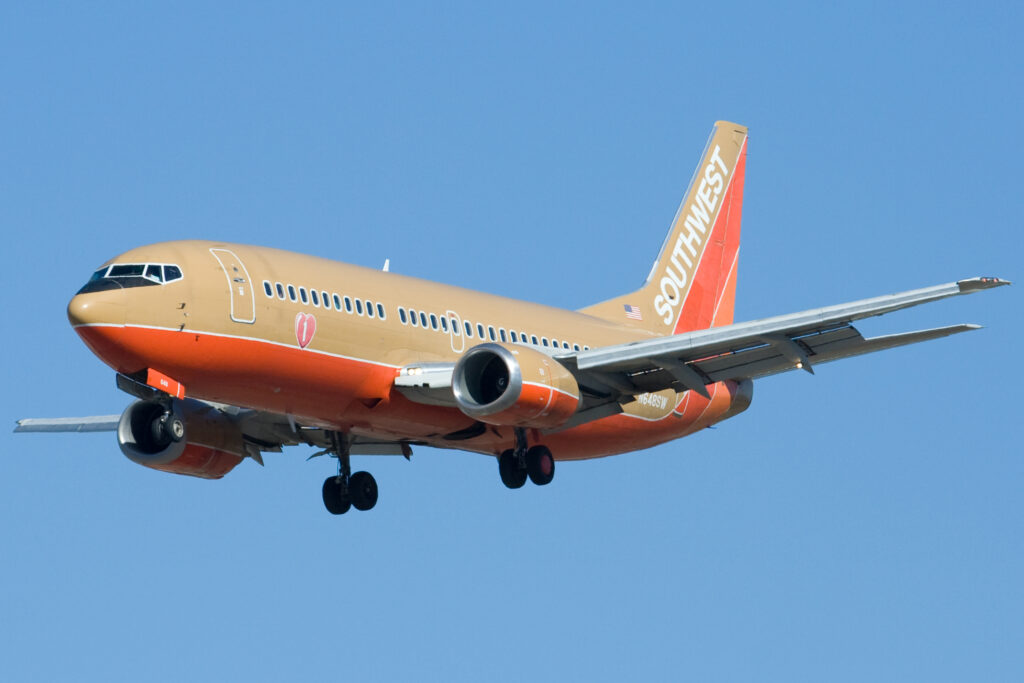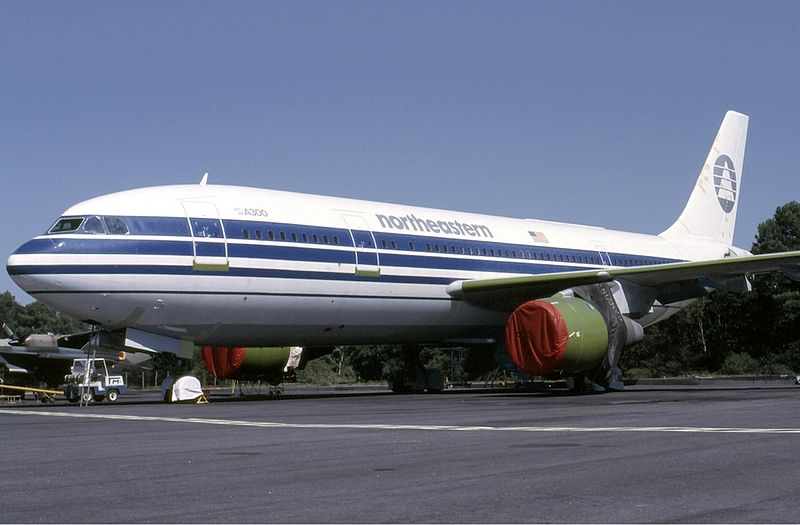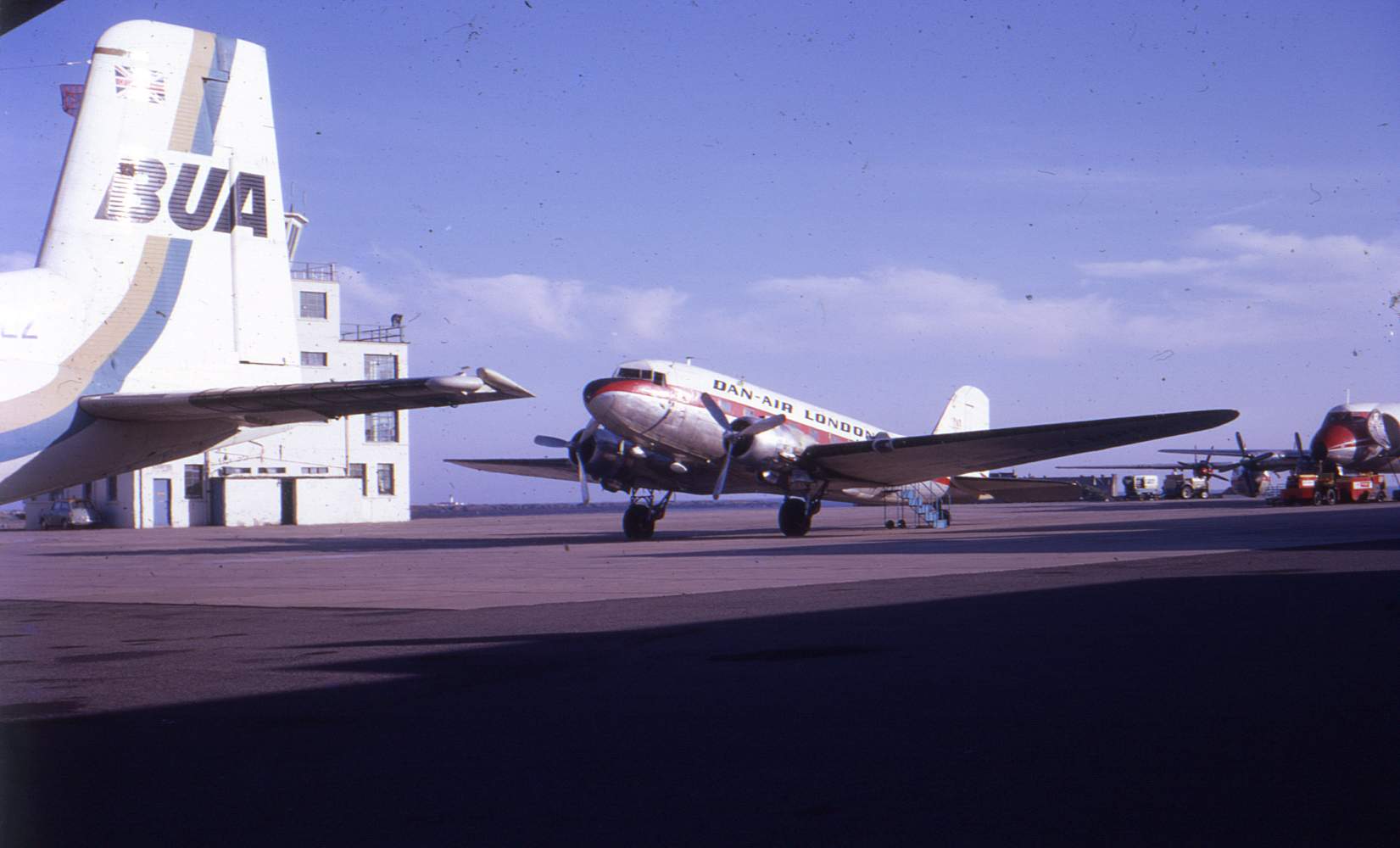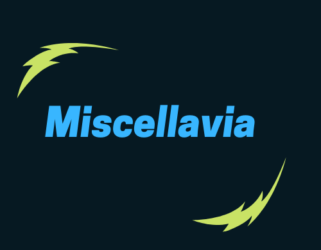Following the collapse of Sagittair, a trumped-up charge was brought against Quinto in 1973 based on the disputed ownership of some aircraft components. It was two stressful years before the case was dismissed by a judge at the Old Bailey – with harsh criticism from the Prosecutors.
In 1975, Stephen Quinto continued with his inventive freight ambitions with the formation of Panavia Cargo Development in the Italian enclave (in Switzerland) of Campione, a financial haven. Quinto’s business plan was to match-up spare airline capacity with freight forwarder’s requirements. Although initial attempts to lease-purchase aDC-4 N888RH fell through, the operation moved beyond a simple agency function in September 1976 when C-54B Skymaster N88909 was acquired. Between October 1976 and October 1977 the ex-Pan American C-54 was recorded as being leased to Panavia Cargo Development of Miami and the reported plan was to transport livestock between the UK and France. This scheme didn’t develop very far and Quinto moved to the USA. The aircraft was overhauled in Long Beach before moving to Oklahoma to establish operations on a shoestring budget (1). An initial contract for four flights carrying oilfield equipment from Midland, Texas to Saudi Arabia collapsed when it transpired that the client could only provide half-payloads …. and only expected to pay half the charter rate. Subsequently, the DC-4 carried livestock to Maracaibo in Venezuela in December 1976. This coincided with the crash of a Convair livestock carrier and the subsequent grounding of similar flights. This resulted in N88909 being idle for some weeks until new projects arose in mid-1977. The US dock strike of late 1977 generated extra business which led to the DC-4 achieving around 200 flying hours per month.
It was in this mid-seventies period that Stephen Quinto and his wife designed and established the Tensing Pen boutique hotel complex on 5 acres of land at Negril’s Seven Mile Beach, Jamaica. Described in some quarters as a ‘hippy hangout for young couples’, Tensing Pen was named after the Quinto’s dog and comprised a number of cottages cleverly integrated into the rocky seaside landscape. The hotel was subsequently sold to the Murray family as Quinto devoted more time to his new aviation enterprises.
The C-54B moved with the family to Miami and, on November 2nd 1977, was registered to Quinto’s Panavia Cargo Development and, following the dock strike contracts, continued with work around the Caribbean and South America. On 18th April 1978, carrying a full load from Miami, it crashed just short of the runway inbound to North Caicos Island after what was reported as an exceptionally low approach. The two crew and four passengers escaped unhurt but the freighter was a write-off. Quinto subsequently bought former BOAC DC-7C N9000T from Onyx Aviation on 10th November 1978 (2). Surprisingly, it was initially registered to ‘Sagittair Inc’ before being transferred to his new company, Air Freighter Leasing, on 12th March 1979. The aircraft was operated along with ex-Seagreen DC-4 N95589 on ad hoc freight charters around the Americas. Stephen Quinto reported that the DC-7C was a ‘sensitive and fascinating beast and a real joy to fly’ and, indeed, it managed to achieve around 100 flying hours every month without major mechanical issues. Indeed, if fire bombing aircraft are excluded, N9000T was one of the last two DC-7s in commercial operation. Air Freighter Leasing worked with Haiti Cargo International, Santo Domingo de Aviacion and Transportes Aereos Dominicanos to fly regular fresh produce flights to Miami from Haiti and the Dominican Republic. In 1980, Stephen Quinto was extremely happy with his DC-7C but was also looking at supplementing his fleet with DC-6Bs or CL-44Ds. However, Stephen Quinto also had a major new project in his sights which involved passenger transport. Consequently, he sold the DC-7C to the Paterson Aircraft Corporation of Miami in October 1981.
(1) Details of the Panavia and Air Freighter Leasing operations are taken from Stephen Piercey’s article ‘Quinto and the Magic 7’ published in Propliner magazine #7.
(2) The DC-7C had been idle for some years and Propliner reports that it was sold to Sagittair Inc by Jack Richards Aircraft of Tucson.
Northeastern International.
The next venture was to be his biggest aviation enterprise of all. Stephen Quinto’s new ambition was to establish a low-cost passenger line which would compete with the US airline majors. Although not a new idea, it had, until 1978, been hampered by the Civil Aeronautics Board which had prevented airlines flying between US states from setting their own competitive fares. Ten large airlines dominated 90% of the market and fares were expensive. The rules had been instigated to promote domestic airline growth in an environment free from predatory pricing. The regulated major airlines had much higher fares on the interstate routes than airlines which flew solely within a single state and could set their own fares. One of the front-runners of the intra-state operators was Southwest Airlines founded in Texas by Herb Kelleher and Rollin King. They had incorporated the company in Texas in 1967 having had their own back-of-a-beermat business planning session in a San Antonio bar (1). Although Southwest’s early operations were plagued by legal action from other airlines, by 1971 they had eventually managed to inaugurate cheap economy flights between San Antonio, Dallas and Houston with the grudging approval of the CAB. The larger airlines tried to stamp on the three-jet airline with their own predatory pricing. Braniff offered $13 tickets on Southwest’s only seriously profitable route: Houston to Dallas. Southwest fought back with a novel innovation – it offered the equivalent ticket at $13 or passengers could pay $26 for premium service which included a free bottle of top quality spirits. The airline briefly became Texas’s largest distributor of premium liquor and saw-off the challenge from Braniff (2). Today, Southwest are the World’s largest economy carrier while Braniff and its colourful fleet of aircraft disappeared from the skies in 1982. Braniff had resisted the proposed 1978 deregulation act as they feared that they would be caught between the agile discount airlines seeking to serve only prime cities and the larger operators which could still set their own higher fares. They were proved right.
(1) Details from www.simpleflying.com
(2) Extra details from www.airandspace.si.edu

President Carter signed the Airline Deregulation Act in October 1978, the formation of new airlines expanded, ticket sales boomed and existing regional operators, such as Southwest, expanded into wider markets. It was in this environment that Stephen Quinto saw scope for a new airline. His Air Freighter Leasing operation was based in Miami and he had memories of his brother’s operations from Long Island, New York. His initial plan was for an economy service between Fort Lauderdale, Florida, and a Long Island airfield, Islip/ MacArthur. This would avoid the higher cost major airports, which were often dominated by larger airlines, and provide a popular service on a previously unserved route. Quinto was correct in spotting that deregulation offered an opportunity but other problems were circling: the 1981 air traffic controllers strike was damaging the aviation industry, fuel prices had risen sharply and high credit card interest was discouraging spending. Northeastern International had been formed by travel executive Robert Rutkowski in March 1980 and had been granted a CAB charter authority that December. It was, however, still largely a paper company when bought by Stephen Quinto in June 1981. The airline was given permission to start scheduled operations as soon as the ATC strike was resolved (3) and the first flight was made on February 11th 1982 between Islip and Fort Lauderdale using the flight code ‘QS’. The assets Stephen Quinto initially employed have been reported as $250,000 plus the first aircraft, an aging Douglas DC-8 which was to be the only aircraft Northeastern ever owned.
From the beginning, the new airline was up against the established carrier, Eastern Airlines, and the new arrival, Peoples Express, on the New York to Florida routes (4) but this didn’t seem to harm initial growth. Four rotations were flown weekly between Islip and Fort Lauderdale and one to Orlando. The low fares made the schedules popular and over 111,000 passengers had flown with Northeastern by the end of 1982. The airline adopted the slogan ‘a lot of airline for a little money’. Two further DC-8s were leased-in from Evergreen, N800EV and N801EV, and remained in their owners colours and 185-passenger configuration. Other DC-8s operated by Northeastern the following year (1983) included N752UA, Thai-owned Danish-registered OY-KTE and Arrow Air’s N8973U. The bargain tickets, however popular, didn’t make for big profits and, at the end of 1982, a loss of $1.4 million was reported (5).
(3) The strike ended but, owing to Reagan’s authoritarian actions firing the existing ATC workforce, it was never properly resolved.
(4) Eastern flew between the major cities, New York and Miami, Peoples Express linked Newark New Jersey to Sarasota and Palm Beach.
(5) Figures from www.worldhistory.biz
While the airline operated relatively low-capacity aircraft over low level routes, the large airlines seem to have left them alone. However, Quinto had big expansion plans and the route network was boosted in the second year to seventeen destinations including major cities such as Los Angeles, Chicago and Philadelphia. Passenger numbers grew to almost 505,000, the staff payroll increased greatly and, by early 1984, Northeastern had taken-over the lease on Pan-American’s Fort Lauderdale terminal. Long Island was the operational base and administration was centred in Fort Lauderdale. The DC-8s had a noise issue and needed replacement: the Evergreen aircraft were returned and operations continued during late 1983 and 1984 with two leased 128-seat Boeing 727s painted in blue and white and pink and white cloud liveries. In a further move, one which mirrored Sagittair’s lease of the Argosy fleet, Stephen Quinto leased two wide body Airbus A300s making Northeastern one of the first two operators of the type in the USA. Formerly operated by Lufthansa, the aircraft offered 314 seats each and propelled Northeastern into competition with the big players. Furthermore, with the introduction of the Airbuses on April 1st 1984, the airline began to serve bigger airports such as New York JFK, Miami and Orlando. A further two Airbuses were introduced on lease from Airbus Financial Services and, during the summer of 1984, the airline operated sixteen aircraft, 66 daily flights to 17 destinations in ten states. With a load factor of 71.5%, higher than any other US carrier, and a workforce of 1600, the airline appeared successful (6). It was even rumoured that British aviation pioneer Sir Freddy Laker was involved at Board level. However, the finances remained precarious: a $5.2 million loss was reported at the end of March 1984 and the airline had insufficient backing to absorb the losses. By September 1984, losses for the last quarter were running at $4.4 million and dramatic changes had to be made. The Airbuses were repossessed, 25% of the workforce was laid-off and some destinations were cut from the network (7).
(6) Extra details from Wikipedia.
(7) Figures from the World Airline Historical Society www.wahsonline.com

Quinto looked for another source of aircraft – the Boeing 727-200s previously operated by the failed Braniff. Northeastern negotiated to take ten of the airliners on wet lease enabling their four older 727s to be returned off lease. However, ownership of the Braniff aircraft lay not with the Texan airline but with their creditors, and the deal was cancelled. By late 1984, Northeastern was left operating only the four older 727s over the airline’s original route. Some commentators suggest that the airline could have been saved at this stage, but Stephen Quinto was unwilling to cede any control to a major new investor. Problems with no-show passengers and a failed service to Hartford, Connecticut, over Christmas 1985 exacerbated the problems and, in early January 1985, the airline filed for bankruptcy protection under Chapter 11 quoting assets of $28 million, liabilities of $48 million and $15 million in debts. The assets were open to question as the only aircraft owned was the original DC-8. This was later sold to United Aircraft of Tulsa for $675,000. The workforce of 500 was further reduced to 200 but, on January 25th 1985, the airline returned to the air with the four 727s flying to Chicago, West Palm Beach and St.Petersburg. The airline was grounded again in March 1985 when Guiness Peat, lessor of the four 727s, demanded their return in view of the $1.3 million owed to the Irish company. Northeastern was sold to JEI Airlines in August 1985 and new wet lease arrangements were made with Emerald Air for several charter flights. This was followed by the lease of a 727-222 from United Airlines which enabled the operation of a rudimentary service between Islip and Fort Lauderdale and St.Petersburg (8).
A fare war during autumn 1985 mitigated against this iteration of the airline making any profit and flying ceased again on November 5th – the annual number of passengers flown was a mere 42,000. A $1 million loan in late 1985 enabled one final burst of activity: Swiss-registered MD-82 HB-IKL was contracted between January and March 1982. However, the FAA insisted that any wet-leased aircraft operated by Northeastern should undergo a route check. When the MD-82 arrived in the USA, Northeastern had insufficient cash to operate it and it was returned to Europe. In May 1985, Northeastern was declared bankrupt.
(8) JEI Airlines was a strange entity. Originally established as a Las Vegas-oriented construction company called Sparks Industries in the early 1970s, it had changed its name in early 1985 in order to buy Jet Executive International, a third level operator based in the US Virgin Islands. The deal fell through and JEI instead bought 83.1% of the Northeastern stock from owner Stephen Quinto. The purchase involved Quinto receiving 45% of JEI’s stock in return for his holding in Northeastern. This made him the largest shareholder in JEI and he was appointed CEO. Details are from Florida newspaper ‘The Evening Independent’ for 24/8/85 using Associated Press material. They quote Quinto as saying ‘We’re a one horse wagon, but it’s pulling the weight, we can reorganise to get out of Chapter 11, that is what the deal with JEI is all about’.
Ultimately, Stephen Quinto’s Northeastern experience had proved to be very similar to that with Sagittair. Both airlines had been started with a clear business aim but with old, cheap equipment and insufficient capital. Low-key operations had been successful enough and had created an enthusiastic market. However, revenues were insufficient to support the over-ambitious expansion at too early a stage. Budget carriers such as Easyjet, Jet2 and Ryanair have pioneered low cost flights with the backing of well-established parent companies bankrolled by shipping and aircraft leasing. The European carriers, like Southwestern in Texas, established close links with aircraft manufacturers and employed modern, virtually single-type fleets. Northeastern operated a motley fleet of aging aircraft, mostly on wet lease, which had varied training and maintenance demands. Southwestern and Easyjet/ Ryanair grew steadily from humble beginnings, built-up a consistent relationship with banks and finance houses and established sound cash reserves. This has enabled them to survive the varied catastrophes which lie in wait for airlines including the recent Covid 19 epidemic. Neither Sagittair nor Northeastern had any such fighting fund and were, generally, under-capitalised from the start.
In terms of the feeding frenzy which accompanied airline deregulation in the USA, the ten airlines which had controlled 90% of the market before the changes consolidated, post-deregulation, and shrunk to only four majors which controlled 80% of the market. Interestingly, one of the four big lines was the Texas newcomer Southwestern.
Meanwhile, Stephen Quinto and family returned to Europe following the final grounding of Northeastern. Initially in the South of France, they moved to Barcelona in 1987. He founded a construction company, Entere SA, which specialised in the restoration of villas. However, his interest in aviation had not completely evaporated and he nourished an ambition to take-over the fading giant Pan American whose decline had paralleled the latter days of Northeastern. The Lockerbie bombing and decline in flying during the first Gulf War sealed Pan-Am’s fate and the airline filed for Chapter 11 protection on 8th January 1991. Quinto moved to New York to pursue the interest in Pan-Am but the political and financial implications of any takeover proved to be beyond his resources.
Surprisingly, the name Sagittair reappeared in the early 1990s in Italy. The air taxi operator Aerotaxi Sud acquired two BAe 146-30s in June 1990 and adopted the new identity ‘Sagittair’. I-ATSC and I-ATSD operated from Naples Capodichino Airport to Milan, Rome and various Mediterranean destinations such as Greece, Spain and Tunisia. Two MD-83s EI-CBR and EI-CBS were leased-in from Irish Aerolease in May 1991. The airline was suffering from cash flow problems and went out of business in 1992. The two Douglas airliners were repatriated to Shannon. Although the name, the colour scheme, logo and, indeed, the financial problems could be familiar Quinto characteristics, no sign could be found of his involvement with the Italian airline management.
Stephen Quinto’s interests moved beyond aviation in the mid-1990s. He had discovered the anti-fungal properties of colloidal silver when maintaining the swimming pool at his French chateau in the mid 1970s. He now used his training in chemical engineering to pursue further research into the anti-bacterial properties of silver and perfected a process which could create the smallest silver particles to date. The tiny particle size produced a proportionately greater silver surface area and the 96% actively-charged silver ions were reputed to create better immunity than other brands. The product was developed by the Quinto family’s Natural Immunogenics Corporation as ‘Sovereign Silver’ with a manufacturing facility at Sarasota in Florida.
In 2006, Stephen and Ruth Quinto started a last great adventure when they moved to Vanuatu in the Pacific and created the Edenhope Project on the island of Espiritu Santo. The project’s aim was to create a sustainable lifestyle and create a bond between mankind and nature….in a paradise. Not a bad line of work. The Quinto’s took a 75-year lease on the estate and invited up to 20 other similarly-minded people to join them in a venture which would avoid society’s consumerism and potentially escape Doomsday. The village comprised timber chalets and walkways interwoven between hardwood trees in a way which developed Stephen Quinto’s earlier interests at Tensing Pen, Jamaica. But life wasn’t without problems in ‘Utopia’ and, in 2017, Quinto filed a complaint against the Vanuatu Minister of Agriculture, Farming, Fishing and Biosecurity on the grounds that timber felling was not being done on a sustainable basis. Worse was to follow: in a dispute over invoicing for slipway services, the Quintos were assaulted while in a Chinese restaurant by expatriate New Zealand criminal Nigel Giltrap (9). Undeterred, Quinto planned to start a second community on Vanuatu but, suffering from health problems, had to return to the family home on the Florida Gulf Coast. On 18th August 2022 Stephen Quinto died at Bradenton, Florida, following complications after a medical procedure (10). In his 87 years he had acquired huge experience in aviation, graphics, design, art and chemistry in North America, the UK, Europe and the Pacific. He was survived by his wife, Ruth (Nicola) Quinto, who had shared his ambitions and projects since the days of Sagittair.
(9) Details from www.c4j.org.vu. Http://media.news.com.au has details and video of Edenhope.
(10) From Stephen Quinto’s obituary on www.dignitymemorial.com
Hits: 262

